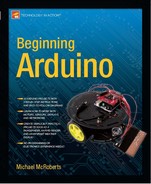Summary
Chapter 5 showed you how to use motors in your projects. It also introduced you to the important concepts concerning transistors and diodes; you will use both of these components a lot in your projects, especially if you are controlling devices that require larger voltages or currents than the Arduino can supply.
You now also know how to construct a H-Bridge and how to use it to change the direction of a motor. You have also used the popular L293D Motor Driver IC; you will work with this chip later on in the book when you look at a different kind of motor. The skills required to drive a motor are vital if you are going to build a robot or a radio controlled vehicle of any kind using an Arduino.
Subjects and concepts covered in Chapter 5
- Using a transistor to power high power devices
- Controlling a motor's speed using PWM
- The current supplied by an Arduino digital pin
- Using an external power supply is essential for high power devices
- The concept of transistors and how they work
- Motors and how they work
- Using a diode to avoid back EMF
- How a diode works
- How motors can be used to generate power
- How vital diodes can be in protecting a circuit
- How to power a motor with an L293D Motor Driver IC
- Why heatsinks are essential for dissipating heat from ICs
- The concept of a H-Bridge and how it can be used to change motor direction
..................Content has been hidden....................
You can't read the all page of ebook, please click here login for view all page.
